An Autumn Tour today. It felt like Autumn too! The temperature just hit a maximum of 14C in the cold and blustery North winds, which were gusting over 35mph at times. At least it was mostly dry, with even some sunny intervals at times.
We headed along the coast to Titchwell first – seeking the benefit of hides to offer us some shelter from the wind and the threat of some early showers. Walking out onto the reserve along the main path, we stopped briefly to look at the grazing meadow pool. Despite the recent rain, this is still very dry. A few Lapwing were out around the shallow pools and a pair of Red-legged Partridge were sheltering from the wind below the reeds.
Out on the reedbed pool, there were a few Gadwall on the water. A closer scan through them revealed a slightly larger duck, dark-capped and pale-cheeked, a female Red-crested Pochard. A couple of Common Pochard were diving at the back and a single Tufted Duck at the front. There were lots of hirundines out over the reeds, mostly House Martins, flying low as they tried to find insects in the wind. In amongst them we picked up a couple of late Swifts, the first we have seen for a few days now – most of our Swifts have already departed.
While we were still on the main footpath, we saw a commotion over the freshmarsh and all the birds took to the air. We couldn’t see what caused it from where we were standing, but a big group of Lapwing and Ruff flew over the path ahead of us and dropped down on the saltmarsh. Small groups of Lapwing were also huddled round the small pools and in amongst them we could see a few Redshank and a single Grey Plover.
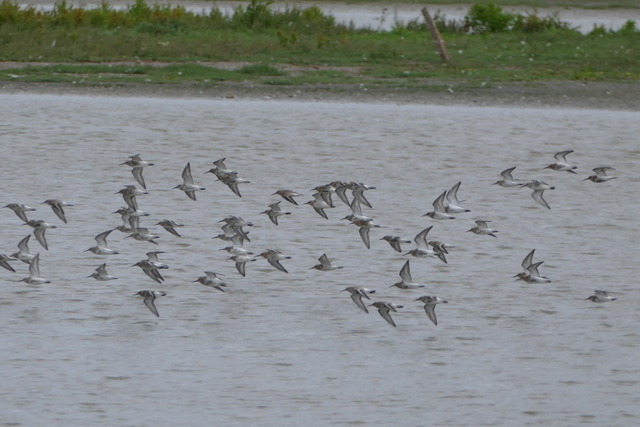 Dunlin – a flock of around 60 on the freshmarsh today, all juveniles
Dunlin – a flock of around 60 on the freshmarsh today, all juveniles
The water levels on the freshmarsh have dropped again, after all the rain last week, and there were more waders around once more today. In particular there were more Dunlin than during the week, with a tight flock of around 60 feeding on the exposed mud. All of them were juveniles, with black-streaked bellies. They were very jumpy – not helped by the wind which often seems to make the birds more nervous – and kept taking to the air and whirling round. On the edge of the islands, there were quite a few Ringed Plover today as well – at least 10.
Many of the waders were sheltering from the combined effects of the impending high tide out on the beach and the North wind. There was a good flock of roosting Bar-tailed Godwits, mostly now in winter plumage but with several juveniles and the odd bird still sporting the remnants of orange summer underparts. Amongst them were a few Knot – much smaller, dumpier and greyer. Another flock of Knot flew back in and landed on the edge of one of the larger islands with a group of Turnstone. Several more Turnstone were sheltering amongst the bricks on one of the smaller islands. The high tide and wind had also brought a number of gulls in off the beach – a good selection of the regular species, including both Great & Lesser Black-backed Gulls.
Plenty of the ever-present Avocets were still out on the freshmarsh, though not in the record numbers of a month or two ago. We watched one feeding in front of the hide, sweeping its bill from side to side through the water as it walked forward. There were also still good numbers of Ruff – the adults now in winter plumage, plus many browner juveniles.
 Ruff – paler winter plumage adult to left, browner juvenile to right
Ruff – paler winter plumage adult to left, browner juvenile to right
The waders were getting spooked easily in the wind, but when everything went up in unison again, in a mass panic, a scan of the sky revealed a young Peregrine flying over.It didn’t attempt to chase after anything but was still seen off by one of the local Lapwings. There are also increasing numbers of duck now on the reserve. It has been a feature of the last few days, with flocks of ducks arriving over the sea from the continent. A large flotilla of Wigeon out on the freshmarsh probably contained several birds which may have arrived from Russia that very morning.
We had looked along the edge of the reeds from Island Hide for any Bearded Tits, but it seemed unlikely we would see any today in the windy conditions. However, from round at Parrinder Hide one was visible across the freshmarsh, working its way low along the base of the reeds on the edge of the mud. We got it in the scope and got a quick look at it before it disappeared back into cover. The other highlight from this side of the freshmarsh was the group of 10 Spotted Redshanks in the corner by the bank. All now in silvery grey winter plumage, we admired their needle fine bills.
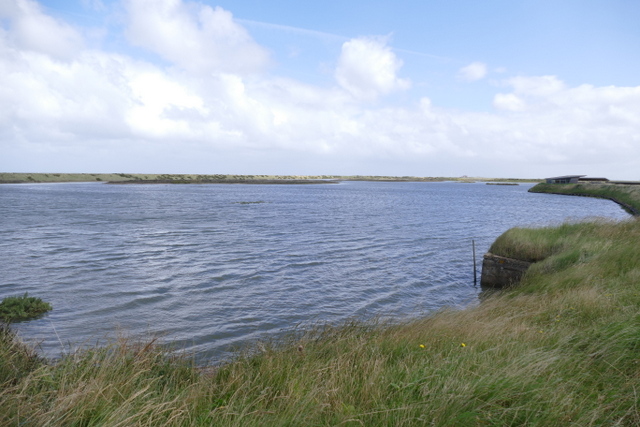 Volunteer Marsh – completely flooded by the tide & wind today
Volunteer Marsh – completely flooded by the tide & wind today
A combination of a reasonably big high tide and the North wind meant that the Volunteer Marsh was completely flooded by the sea today. However, there was a lot more activity (or inactivity!) on the tidal pools. Many more waders were roosting on here, sheltering from the wind and waves on the beach. There was a big flock of Oystercatchers hiding in amongst the saltmarsh vegetation and several Grey Plovers on one of the spits of mud. Hiding on one of the small islands we found a single Greenshank in amongst a small group of Redshank, much greyer backed compared to the browner Redshanks. Several Black-tailed Godwits had come out here to feed around the edges of the mud.
 Black-tailed Godwit – several feeding on the tidal pools today close to the path
Black-tailed Godwit – several feeding on the tidal pools today close to the path
It was very windy out on the beach – the sand was being whipped up as we climbed over the remains of the dunes. The tide was very high, and the sea was very rough. However, the view was stunning – it is always amazing to see the power of the sea on day’s like today. There was even some blue sky!
 The beach – high tide & big waves in the wind
The beach – high tide & big waves in the wind
There were several Gannets passing by offshore, and four birds arced past us quite close in. We could see an adult in the lead, with black-tipped white wings, two dark grey juveniles and an immature bird in between. A little group of waders came along the shoreline – four Dunlin accompanying a single Sanderling. The latter presumably didn’t fancy running in and out of the waves on the beach on a day like today!
 Gannets – passing by offshore, over a rough sea
Gannets – passing by offshore, over a rough sea
Is was blustery and exposed out on the beach, so we didn’t hang around. We walked quickly back along the path. We had just about walked past the grazing meadow pool when a quick glance back and we spotted a Common Sandpiper feeding on the mud in the front corner.
We took the detour round via Meadow Trail to Patsy’s. The sallows along Meadow Trail itself were quiet, but further along and out of the wind by the junction to Fen Trail we came across a large mixed flock of tits – Long-tailed Tits, Blue Tits and Great Tits, together with one or two Chiffchaffs and a few Chaffinches.
There were lots of moulting ducks on the islands on Patsy’s Reedbed, mostly Mallard and Gadwall, plus a couple of Shoveler and Common Pochard. There were not many waders, apart from several more Ruff, mostly brown-toned juveniles. However, a single Snipe feeding on the bank was a nice addition to the day’s list. Always smart birds to see.
 Snipe – feeding on the bank round at Patsy’s Reedbed
Snipe – feeding on the bank round at Patsy’s Reedbed
After scanning Patsy’s Reedbed, we had a quick look round along the Autumn Trail. There were lots of Common Darters sheltering from the wind along the path, trying to warm up in the sunnier intervals.
 Common Darter – trying to bask out of the wind on the Autumn Trail
Common Darter – trying to bask out of the wind on the Autumn Trail
A Bloody-nosed Beetle was also making its way slowly along the path and further along a Common Toad walked past. Round at the back of the freshmarsh, another Common Sandpiper flew across from the edge of the reeds towards the bank ahead of us, out of view. Then we headed back to the car for lunch. A Bullfinch was calling from the trees in the car park, but wouldn’t show itself.
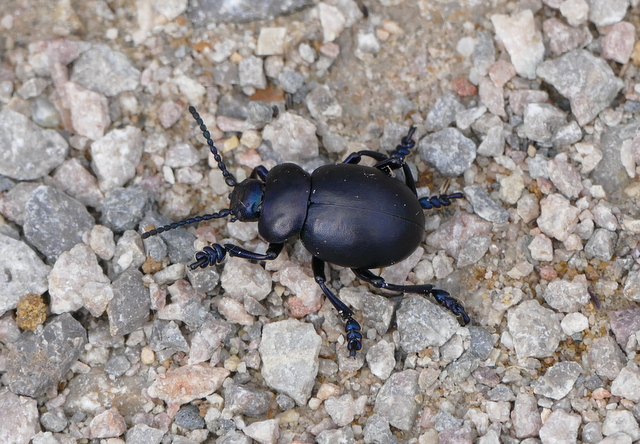 Bloody-nosed Beetle – walking along the Autumn Trail
Bloody-nosed Beetle – walking along the Autumn Trail
After lunch, we drove back along the coast to Warham Greens. We were hoping for some passerines to add to our tally for the day and this is always a good place to look for warblers in early autumn. However, it was still just too windy today, despite the wind easing a touch. We flushed a Whimbrel from the edge of the saltmarsh, and it flew a short distance and landed again, so that we could get a good look at it in the scope. There were some big flocks of Golden Plover out on the saltmarsh, very hard to see roosting amongst the vegetation but a couple of times they were spooked and flew round in a tight flock. A single Greenshank flew west, calling.
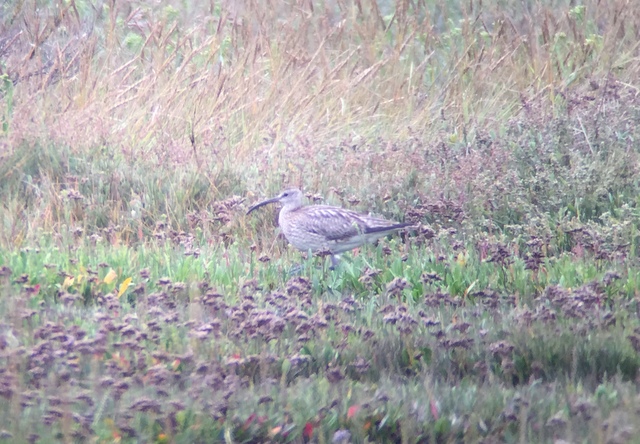 Whimbrel – feeding out on the saltmarsh
Whimbrel – feeding out on the saltmarsh
Further out, two Marsh Harriers were quartering the saltmarsh. Much closer, a Kestrel was hovering over the grass by the path. The trees and hedges were quiet today but we did manage to find a few passerines in the bushes in the shelter of the old pit. Several Reed Buntings flew up from the Suaeda bushes by the path as we approached and dropped down into cover. In amongst the brambles and elder bushes we could hear a couple of Blackcaps calling and a smart male flew across and landed briefly in front of us. A Lesser Whitethroat appeared from the brambles, looking very smart with powder-grey crown and grey-brown back. Not surprisingly, given the weather, there was no sign today of the Barred Warbler which has been in the bushes in the pit recently. We didn’t hang around too long, and headed back to get out of the wind. On the way back, a Sparrowhawk flew up along the path ahead of us.
From there, we drove on to Stiffkey Fen. In the wood alongside the path, we came across another tit flock, but they were hard to see in the shelter of the trees. A Blackcap was calling from the brambles by the river, but did not venture out. At the Fen itself, we were disappointed to see that the water level was still very high and there were almost none of the islands left exposed. It looked like it might be a wash out as we walked out but then, amongst a small flock of Black-headed Gulls, we noticed a larger white shape, a single Spoonbill. Even better, it was not up to its usual tricks – this Spoonbill was awake!
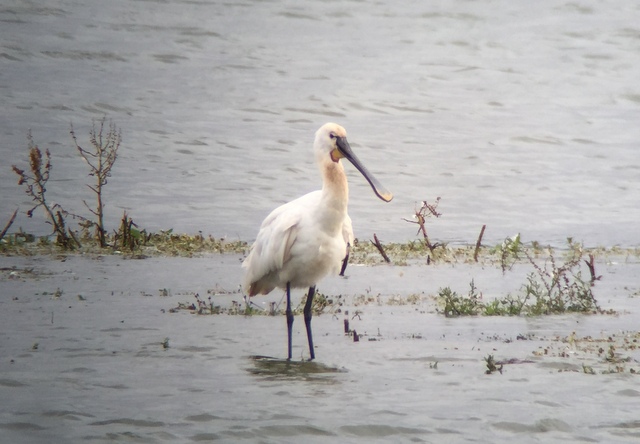 Spoonbill – this adult was on the Fen briefly this afternoon
Spoonbill – this adult was on the Fen briefly this afternoon
From up on the seawall, we could get the scope on the Spoonbill. It was busy preening, but when it stopped we could see its spoon-shaped bill, The yellow tip confirmed it was an adult. There was very little else of note out on the Fen today – a few Ruff and, as elsewhere along the coast, an increasing number of duck. However, a closer scan through the Teal, Gadwall, Shoveler and Wigeon revealed a couple of Pintail feeding on one of the islands. Unfortunately, all the ducks are in eclipse plumage at the moment so the males are not looking their best, in more female-like brown plumage.
On the other side of the seawall, there was a very noisy dog which had been allowed by its owner to run amok. It was swimming about in the creek and barking loudly. Needless to say, there were no birds left. We walked round to the harbour and could see a selection of the usual birds out on the mud – lots of Oystercatcher, several Curlew and Redshank, and lots of assorted gulls. Closer, a Grey Plover and a Turnstone were feeding in the creek in front of us.
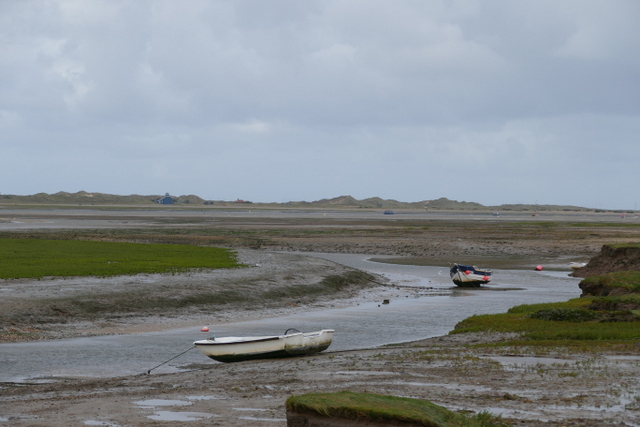 Blakeney Harbour – the view across to Blakeney Point from Stiffkey Fen
Blakeney Harbour – the view across to Blakeney Point from Stiffkey Fen
It was still very windy, so again we didn’t linger too long out in the harbour before we headed back to the Fen. By now, the unruly dog had gone. As we walked back along the seawall, a Common Sandpiper flew along the opposite bank of the creek in front of us. It landed for a while, bobbing its tail up and down, before flying off again onto the saltmarsh. A Whimbrel flew in calling. Then a Greenshank dropped into the creek with a couple of Redshank. It fed for a while along the opposite side and we got a good look at it in the scope.
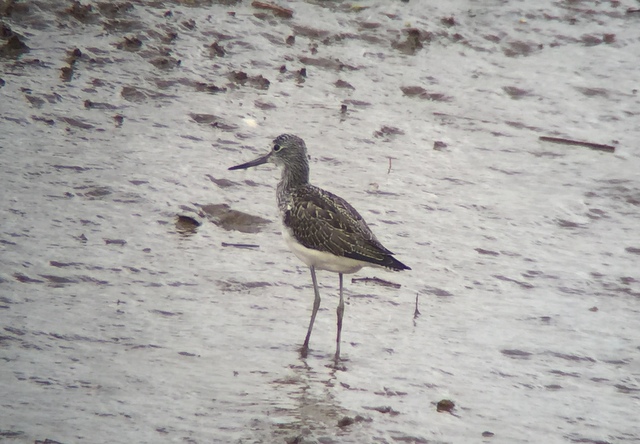 Greenshank – dropped in to the muddy creek to feed
Greenshank – dropped in to the muddy creek to feed
There was no sign of the Spoonbill when we got back – we had been lucky to see it when we did. There was nothing else new on the Fen and, with the afternoon getting on, it was unfortunately time to call it a day.
















